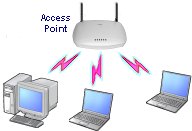Back to Contents
Wireless Network Overview: Intel(R) PRO/Wireless 3945ABG Network
Connection User Guide
About Wireless Network Technology
A wireless network connects computers without
network cables. Instead computers use radio communications to send data between each
other. You can communicate directly with other wireless computers, or
connect to an existing network through a wireless access point. When you set
up your wireless adapter, you select the operating mode for the kind of
wireless network you want. You can
use your Intel(R) PRO/Wireless Network Connections adapter to connect to other
similar wireless devices that comply with the 802.11 standard for wireless
networking.
Select a Wireless Network Mode
Wireless networks can operate with or without access points,
depending on the number of users in the network. Infrastructure mode uses access
points to allow wireless computers to send and receive information. Wireless
computers transmit to the access point, the access point receives the
information and rebroadcasts it to other computers. The access point can also
connect to a wired network or to the Internet. Multiple access points can work
together to provide coverage over a wide area.

Device-to-Device mode, also called Ad Hoc mode, works without
access points and allows wireless computers to send information directly to
other wireless computers. You can use Device-to-Device mode to network computers in
a home or small office or to set up a temporary wireless network for a meeting.

Configure a Wireless Network
There are three basic components that must be configured for an 802.11 wireless
network to operate properly:
- Network Name: Each wireless network uses a unique
Network Name to identify the network. This name is called the Service Set
Identifier (SSID). When you set up your wireless adapter, you specify the SSID.
If you want to connect to an existing network, you must use the name for that
network. If you are setting up your own network you can make up your own name
and use it on each computer. The name can be up to 32 characters long and
contain letters and numbers.
- Profiles: When you set up your computer to access a
wireless network, Intel(R) PROSet/Wireless creates a profile
for the wireless settings that you specify. If you want to connect to another
network, you can scan for existing networks and make a temporary connection, or
create a new profile for that network. After you create profiles, your computer
will automatically connect when you change locations.
- Security: The 802.11 wireless networks use encryption to help protect your data. Wired equivalent privacy (WEP) uses a 64- or 128-bit shared encryption key to scramble data. Before a computer transmits data, it uses a secret encryption key to scramble the data. The receiving computer uses this same key to unscramble the data. If you are connecting to an existing network, use the encryption key provided by the administrator of the wireless network. If you are setting up your own network you can make up your own key and use it on each computer.
802.1x authentication is independent of the 802.11 authentication process. The 802.1x standard provides a framework for various authentication and key-management protocols. There are different 802.1x authentication types, each providing a different approach to authentication but all employing the same 802.1x protocol and framework for communication between a client and an access point
Identify a Wireless Network
Depending on the size and components of a wireless network,
there are many ways to identify a wireless network:
-
The Network Name or Service Set Identifier (SSID)—Identifies
a wireless network. All wireless devices on the network must use the same SSID.
-
Extended Service Set Identifier (ESSID)—A special case
of SSID used to identify a wireless network that includes access points.
-
Independent Basic Service Set Identifier (IBSSID)—A
special case of SSID used to identify a network of wireless computers configured
to communicate directly with one another without using an access point.
-
Basic Service Set Identifier (BSSID)—A unique
identifier for each wireless device. The BSSID is the Ethernet MAC address of
the device.
- Broadcast SSID—An access point can respond to
computers sending probe packets with the broadcast SSID. If this feature is
enabled on the access point, any wireless user can associate with the access
point by using a blank (null) SSID.
Back to Top
Back to Contents
Trademarks and Disclaimers